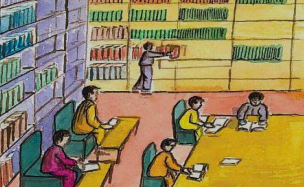Perhaps part of the reason it is hard to find girls in Afghan classrooms is because women and girls are hard to find in textbooks?
A report produced by the Ministry of Education in 2007 says that while 85% of female students in Afghanistan completed elementary school, less than 5% had the chance to study beyond middle school. Whether the statistics are accurate or not, Afghanistan does have a significantly small number of female high school graduates.
The report counted child marriage, poverty, lack of security and lack of resources and facilities as major factors in decreasing the number of female students in schools after elementary school. While all these reasons carry a lot of weight, little attention is paid to whether or not schools are welcoming to girls and whether the texts that are taught and teachers encourage girls to continue their education.
The majority of books taught in Afghan schools either excludes women all together, or misrepresents them. For example, Dari literature textbooks for grades five and six often disregard the presence of women in classrooms and the roles that Afghan women actively play in their communities and/or limit them to the traditionally “feminine” roles, such as motherhood. Almost all of drawings, pictures, introductions of heroes, fables, anecdotes, and moral instructions contain only male characters or one or two minor female ones. Women are mostly discussed in relation to men and in the context of their homes only.
A drawing accompanying the essay Sports and Health in the fifth grade Dari book shows seven boys running in a soccer field. Whenever sports are mentioned, only boys are seen in drawings.
Even though women make up nearly 50% of agricultural workers in Afghanistan, according to the drawings in these books, farming, too, is exclusive to men.
All police, traffic managers, pottery makers, builders, doctors, and factory workers depicted in the drawings and photographs in these two books are men, as well. Nearly all of these jobs are occupations done outside the homes and their portrayal as jobs exclusive to men hints that in these books women are limited to their houses.
In addition to that, female authors from classical poets such as Rabi’a Balkhi, Naazo Ana and Mukhfi Badakhshi to contemporary writers such as Parwin Pazhwak, Khaleda Forogh, Nadia Anjuman and Homaira Qaderi, have all been excluded from these books. The only time there is a photograph of a woman is when the topic of the lesson is motherhood and once in more than 300 pages of textbooks, a picture of a female teacher appears.
The invisibility of women in all other fields of the society according to the textbooks, unconsciously leads to girls thinking of themselves as mothers only and not imaging how with education, they can discover other fields or life-styles as well and prevents them from having non-traditional dreams or role models.
Women’s representation in the textbooks is essential for girls to feel welcomed at schools and be provided with successful role models and to normalize the participation of women in the public life. The textbooks should focus on providing examples of how women have contributed to the welfare of societies and how the future generation, male and female, can work together to rebuild the country. This will not only have a positive impact on the female students but, will also influence male students to view women positively.
An accurate representation of successful women presents children with the realistic message that no country can progress if half of its population is invisible in the social, economical and political scene. If we want to change gender roles in Afghanistan, a good place to start is with the textbooks.
Images from Dari Literature Textbooks for Grades 5 and 6



